PV column
energy
2023/10/11
Renewable Energy Employment Jumps to 13.7 Million in 2022
The International Renewable Energy Agency (IRENA) released a report in late September 2023 on employment in the global renewable energy industry. This report was prepared by the International Renewable Energy Agency (IRENA) and the International Labour Organization (ILO).
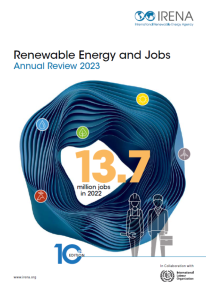
https://www.irena.org/Publications/2023/Sep/Renewable-energy-and-jobs-Annual-review-2023
In this column, we will introduce announcements and reports on employment in the renewable energy industry.
**********
Joint News Release
(This joint announcement is also available in English, Arabic, Chinese, French, Russian, and Spanish.)
Employment expands despite crises and challenges and growing use of industrial policies can create more localised supply chains, a new report finds.
Abu Dhabi, United Arab Emirates / Geneva, Switzerland, 28 September 2023 – Worldwide employment in renewable energy reached 13.7 million in 2022, an increase of one million since 2021 and up from a total of 7.3 million in 2012, according to a new report by the International Renewable Energy Agency (IRENA) and the International Labour Organization (ILO). The tenth edition of Renewable Energy and Jobs: Annual Review 2023, is the product of a continuing collaboration between the two agencies.
The report found that renewable energy is attracting increasing investment, leading to job creation in a growing number of countries. However, as in previous years, most of the jobs are concentrated in a few states, notably China, which accounts for 41 per cent of the global total. Brazil, European Union (EU) countries, India and the United States of America (USA) were among the others. Together they represent the majority of global capacity installations and play key roles in the manufacturing of equipment, engineering and associated services.
Solar photovoltaics (PV) was once again the largest employer in 2022, the Annual Review found, reaching 4.9 million jobs, more than a third of the total workforce in the renewable energy sector. Hydropower and biofuels had similar numbers of jobs as in 2021, around 2.5 million each, followed by wind power with 1.4 million jobs.
Francesco La Camera, IRENA Director-General, observed that “2022 was another outstanding year for renewable energy jobs, amid multiplying challenges. Creating many more millions of jobs will require a much faster pace of investments in energy transition technologies. Earlier this month, the G20 leaders agreed to accelerate efforts to triple global renewables capacity by 2030 aligned with our recommendations ahead of COP28. I call on all policy makers to use this momentum as an opportunity to adopt ambitious policies that drive the needed systemic change.”
ILO Director-General, Gilbert F. Houngbo, said, “To seize the significant opportunities to attain full, productive and freely chosen employment, social inclusion and decent work for all during these complex transitions, there is a need to develop and implement specific policies for inclusive macroeconomic growth, sustainable enterprises, skills development, other active labour market interventions, social protection, occupational safety and health and other rights at work, and find new solutions through social dialogue.”
The quality of jobs matters as much as their quantity, the study notes. To advance social justice, the transition to a cleaner energy future needs to be just and inclusive for all; workers, enterprises and communities. Hence, coherent and integrated frameworks are indispensable, with a focus on wages, occupational safety and health and rights at work, and based on effective social dialogue. The ILO’s Guidelines for a just transition towards environmentally sustainable economies and societies provide a central reference for policy making and actions to support a just transition that governments and other stakeholders can draw upon.
A just and inclusive energy transition must also pursue workforce development and diversity. The report highlights the need to expand education and training and increase career opportunities for youth, minorities and marginalised groups. Greater gender equity is also essential. At the moment, jobs in renewables remain unequally distributed between men and women. Currently, solar technology has the best gender balance compared to other sectors, with 40 per cent of jobs held by women.
Many countries are showing increased interest in localising supply chains and creating jobs domestically, with support from appropriate industrial policies. This goes hand-in-hand with a growing desire to lessen energy supply insecurities. China has successfully pursued a broad array of these industrial policies for some years. More recently, the EU, India, Japan, South Africa and the USA have announced initiatives to stimulate domestic manufacturing. However, countries will need to find ways to combine localisation efforts with continued global cooperation in pursuit of an ambitious energy transition.
Read the full report here.
See an interactive story on A decade of progress: Renewables jobs on the rise, and please refer to the following:
**********
Renewable energy jobs soar to 13.7 million in 2022, almost double in 10 years
- As the energy transition progresses, jobs in renewable energy continue to grow.
- The global total reached 13.7 million in 2022, up from 12.7 million in 2021.
- In the last 10 years, employment in renewable energy has almost doubled.
Graph 1. Evolution of global renewable energy employment by technology, 2012-2022
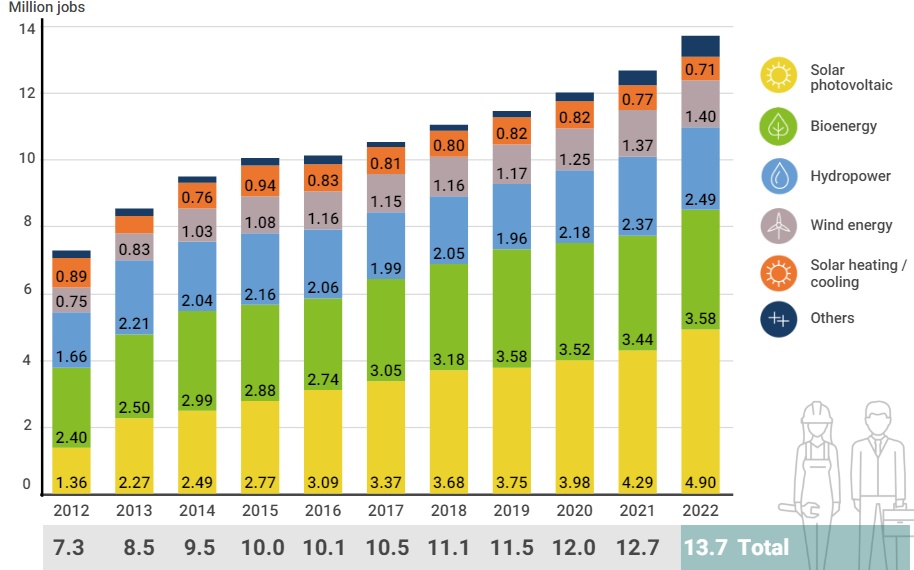
Solar and wind power remain the most dynamic
- Solar PV and wind attract the bulk of the world’s renewable energy investments and are thus most dynamic.
- Solar PV is still the fastest-growing sector with almost 4.9 million jobs in 2022, more than a third of the total workforce in the renewable energy sector.
- Hydropower and biofuels created similar numbers of jobs as in 2021, around 2.5 million each, followed by wind power with 1.4 million jobs.
Graph 2. Global renewable energy employment, by technology, 2022
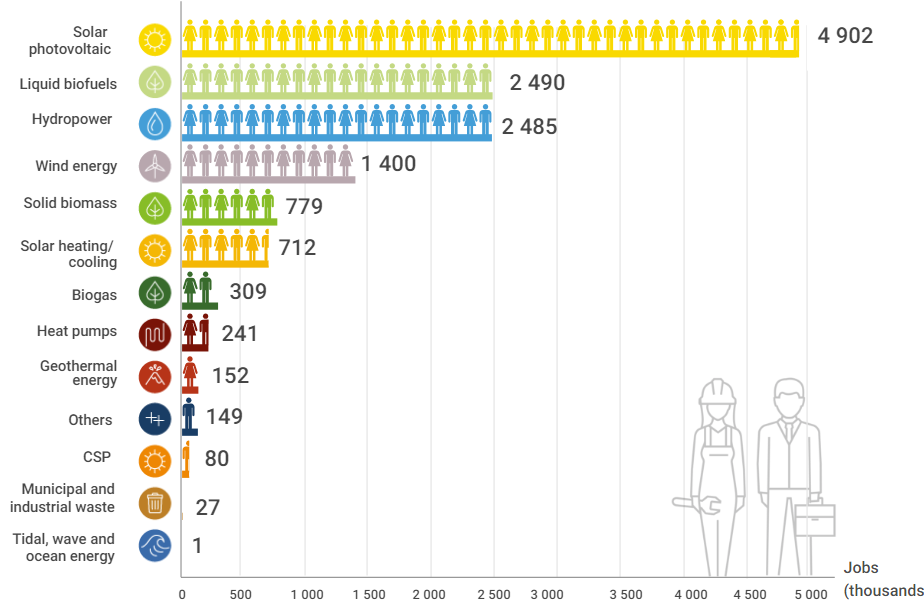
DRE (Decentralised Renewable Energy) creates opportunities for a varied skill-set
- Decentralised solutions not only provide reliable power but offer employment opportunities as well, including in remote areas.
- Small-scale hydropower, for instance, requires anywhere from 17 000 person-days (for a pico plant, which averages 5 kilowatts [kW]), to about 64 000 person-days (for a 50 kW micro plant), to over 160 000 person-days (for a 500 kW mini plant) along the value chain.
- The demand for skilled workers creates many opportunities for a varied set of skills, allowing for local skill building and fostering enterprise development.
- The expansion of the decentralised renewable energy job market has a positive multiplier effect, benefiting local economies, reducing poverty and fostering social development.
Graph 3. Distribution of skills required for pico, micro and mini hydro plants
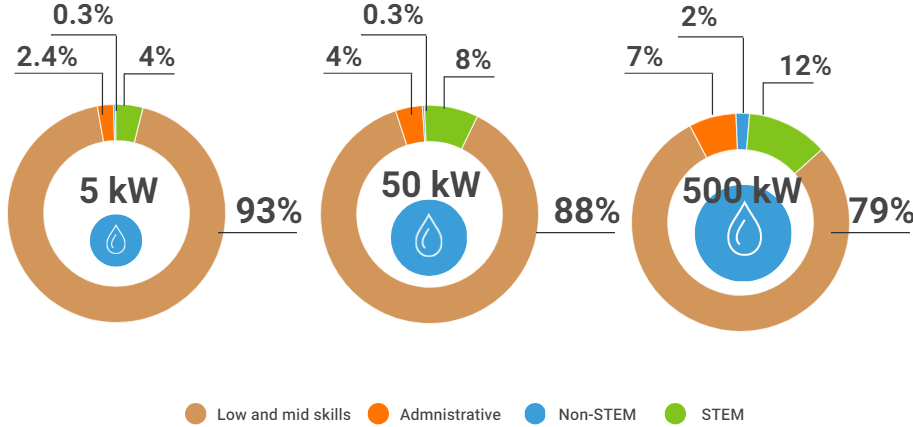
Market leaders retain their status
- Jobs remain concentrated in a relatively small number of countries, reflecting the uneven geographic footprint of capacity installations, manufacturing of equipment, engineering and associated services.
- Close to two-thirds of all jobs are in Asia, where China alone accounts for 41% of the global total.
- Half of the world’s new wind power capacity and 45% of solar PV capacity were installed in China. In wind, China was followed by the United States, Brazil, the United Kingdom, Germany, Sweden and France. In solar PV, the United States, India, Brazil, the Netherlands and Germany followed.
Graph 4. Renewable energy employment in countries and regions (thousand jobs)
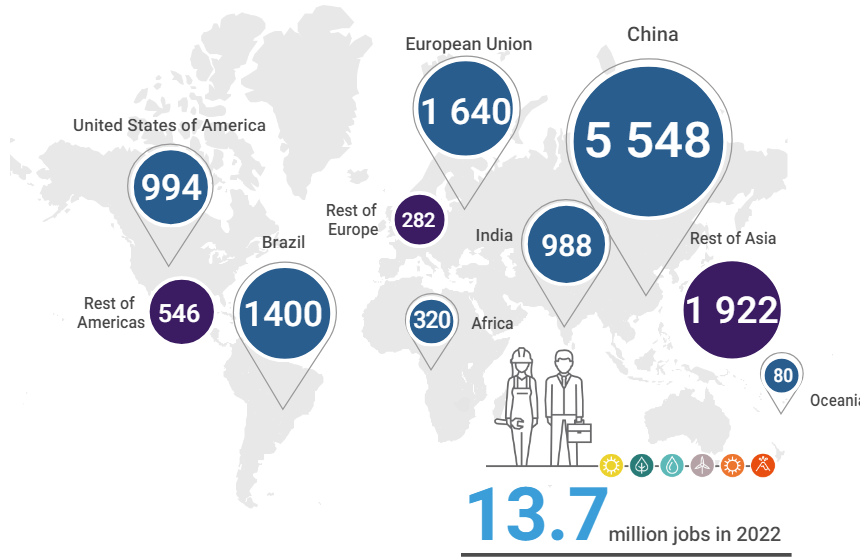
Solar sector employs more women than other renewables
- At 40% of the full-time positions, women’s representation is higher in the solar PV workforce than in other renewable energy technologies, and almost twice as much as in the oil and gas sector.
- Greater gender equity is essential to accelerate a fairer and more equitable energy transition.
- Education and training must be expanded to prevent the widening of skill gaps. Efforts must be made to tap a wider pool of talent, by providing under-represented groups – women, youth and minorities – with equal access to career paths in the historically male-dominated energy industry.
Graph 5. Women in the solar photovoltaic sector compared with other sectors
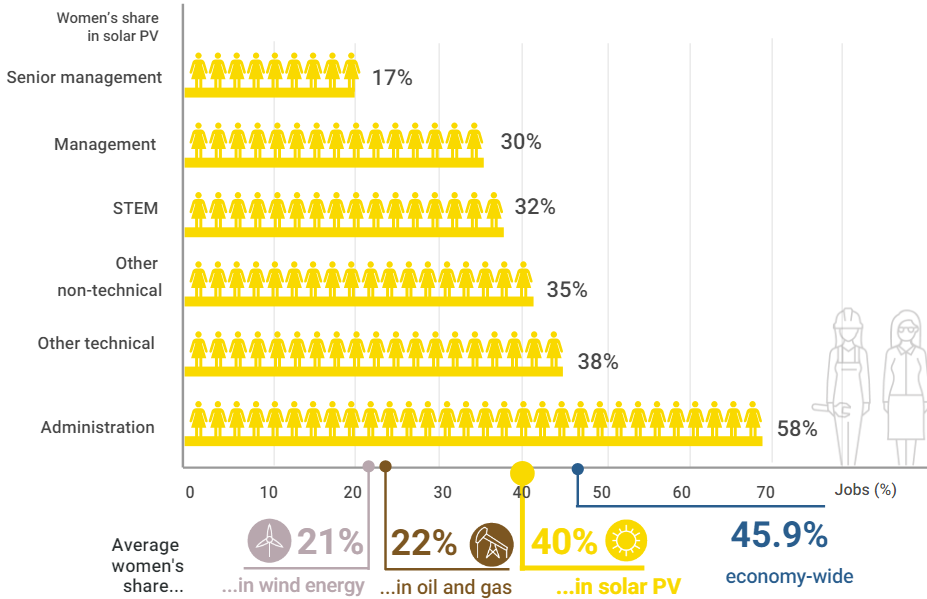
Growing use of industrial policies can create more localised supply chains
- Many countries are showing increased interest in localising supply chains – to guard against disruptions in global supply chains, but also to create more jobs domestically.
- This has led to a resurgence of industrial policy-making, to enhance local capacities and stimulate domestic manufacturing. Among such efforts are initiatives in the the EU, India, Japan, South Africa and the US.
- Meanwhile, a number of resource-rich countries are taking steps to play a bigger role in the energy transition, moving beyond being suppliers of raw materials.
ILO guidelines framework
- IRENA produces the Jobs Review in collaboration with the International Labour Organization (ILO).
- Both agencies stress that the transition from fossil fuels to a cleaner energy future needs to be just and inclusive in relation to workers, enterprises and communities.
- The ILO’s 2015 “Guidelines for a just transition towards environmentally sustainable economies and societies for all” serve as a central reference for policy making.
- In 2023, the International Labour Conference elaborated a practical framework for action based on four building blocks: promoting inclusive, sustainable and job-rich economies; advancing social justice; managing the just transition process and financing a just transition.
Graph 6. ILO guidelines for a just transition: A framework for action
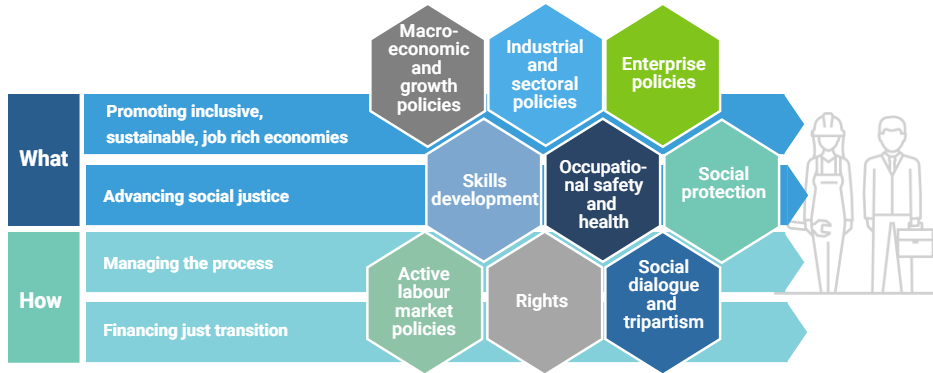
A Holistic policy framework for a just and fair energy transition
- For the energy transition to deliver broad socio-economic benefits, advancing equity among countries and communities, and aligning economies with climate and resource constraints, governments and other stakeholders will have to play a proactive role in transforming economic systems.
- Policy making must be inspired by a holistic framework that not only considers the technological but also socio-economic dimension of the transition.
Graph 7. Holistic policy framework for a just and inclusive energy transition
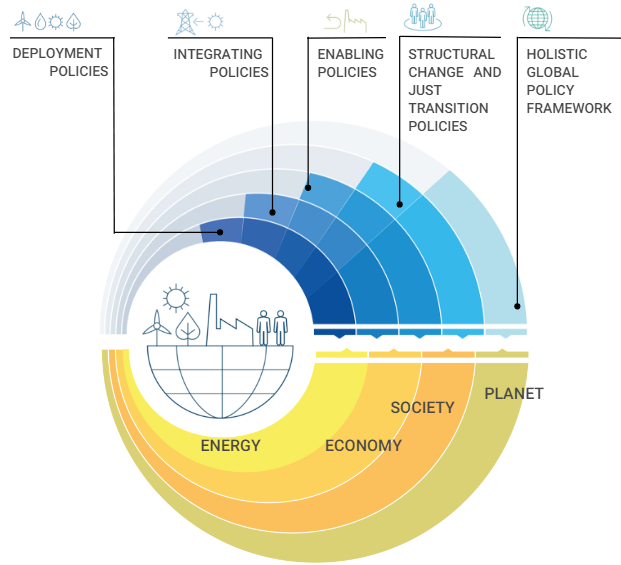
Explore more on this topic
Source: IRENA and ILO (2023), Renewable energy and jobs: Annual review 2023, International Renewable Energy Agency, Abu Dhabi and International Labour Organization, Geneva.
**********
In Japan, there seems to be a shortage of highly specialized human resources in companies that are participating in the photovoltaic and renewable energy industries. In Germany, it has been reported that the time required to start construction is increasing day by day due to a shortage of labor in the photovoltaic industry in response to the growing demand for the photovoltaic facilities.
We will continue to contribute to the development of the photovoltaic industry.

